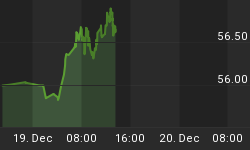There's a journalistic sub-genre that might be called "The Highest/Lowest Since XXX," in which a reporter takes a current statistic and illustrates (often with snazzy charts) how it hasn't been this high or low since some date in the distant past. This is a compelling theme, implying as it does that the connection between now and then makes the current situation more important or meaningful while providing context with which to judge current trends.
Unfortunately, these articles often miss the point of the whole context thing by not exploring what subsequently happened last time the stat in question hit that level. Here's a good recent example from Bloomberg:
For the First Time Since 2007, Most Americans Feel Good About Money
For the first time since 2007, more than half of Americans, 52 percent, say their financial situation is "getting better," a new Gallup poll shows. That's up from a low of 29 percent three years ago.
A third of Americans still say their finances are getting worse, Gallup says. But that's a big improvement from the poll's 2008 peak, when 49 percent of respondents said things were going south.
Millennials are the most optimistic of any group in the survey. Seventy percent of 18-to-29-year-olds say their financial picture is improving, up from 60 percent last year. Meanwhile, just 33 percent of those 65-plus are feeling better.
Not surprisingly, the wealthier you are, the better you feel. Of those making $75,000 or more, 65 percent say they're doing better. For those earning less than $20,000, the number is 36 percent, though that's up 7 points from last year.
The reasons for the improving mood include a rising stock market, falling debt levels, and a better job market.
What's amazing about this article from an analytical standpoint is that while mentions in passing that the 2007 high in good feelings was followed by a low in 2008, it doesn't connect the two numbers. This, it would seem, is the key piece of the puzzle: if the stat matters enough to be article-worthy, then a discussion of why it matters should be mandatory. And if its previous high was followed by a catastrophic low, the reason for this reversal should be the story's narrative center.
So here's what it means: Extreme optimism -- whether in the form of stock valuations, consumer spending, or happiness surveys like the one mentioned here -- tend to be followed by corrections because to get to an extreme point in a data series, extreme behavior is usually required. That is, a lot of really optimistic investment decisions have to be made to push financial markets to cyclical highs, and these kinds of moves tend to exhaust themselves and produce big moves in the other direction. Hence the 2008 low following the 2007 high.
If reporters got this, and asked the two obvious questions "what happened next and why did it happen?" these articles would contain a lot more useful information. But of course they also wouldn't lead readers to borrow, spend and speculate, which seems to be the overall goal.
And while we're on the subject of reporters not getting life's cyclicality, check this out:
Wall Street's 2007 Heroes Ascendant as Goldman, Blackstone Surge
Goldman Sachs Group Inc. and Blackstone Group LP were the toast of Wall Street in 2007 as they raised record-setting funds and earned returns of more than 30 percent. Eight years later, they captured some of that dominance again in the first quarter.Goldman Sachs rode a rare increase in trading and more than $1 billion of gains from equity investments made with its balance sheet to post the highest earnings per share in five years. Blackstone, the largest alternative-asset manager, doubled first-quarter profit to a record.
Commercial banks' margins remained squeezed by interest rates near record lows, leading to Wells Fargo & Co.'s first profit drop since the global credit crunch of 2008. Goldman Sachs's return on equity, boosted by its highest post-crisis merger advisory revenue, topped Wells Fargo's for the second time in the last four years.
"This quarter, they got some cyclical strength," said Alison Williams, senior financials analyst with Bloomberg Intelligence. "The pick-up shows the opportunity still in these businesses, and supports the view that at the depths of last year, at least some of the weakness was cyclical."
After posting losses in multiple years in the wake of the financial crisis, Blackstone has made steady progress culminating in last quarter's record profit. It has benefited from the increased regulation on banks, entering new businesses and buying assets from financial firms.
Blackstone also gained from the rebound in the U.S. property market, as the real estate group reported a 99 percent jump in profit from a year earlier. Its real estate unit, already the biggest of its kind, has raised almost $15 billion in just four months for a new fund.
"All signs point to 2015 being a very big year for us and our shareholders," CEO Steve Schwarzman, 68, told analysts and investors on a conference call Thursday. "I do not believe Blackstone is in any way at a long-term peak."
















